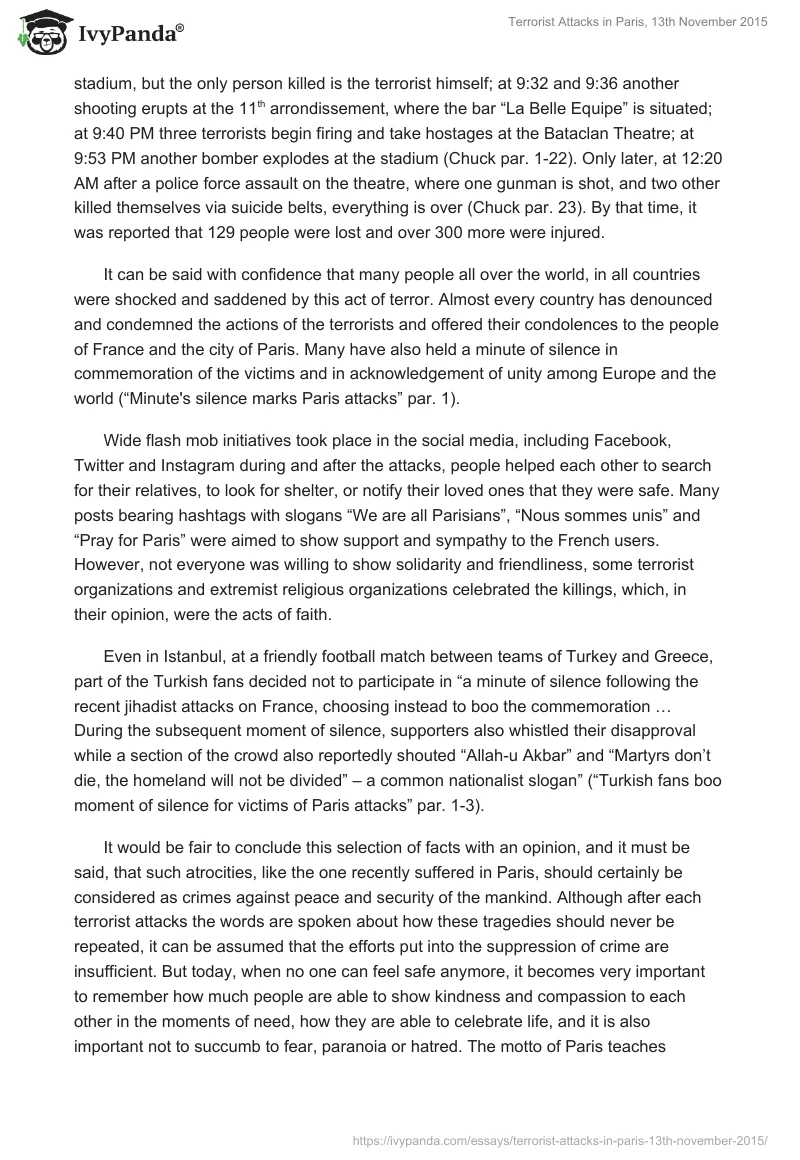On 13th of November, 2015, in Paris and its satellite commune Saint-Denis three terrorist attacks, apparently coordinated, took place; 130 people were killed, 368 were injured, which elevated the scale of this carnage to the deadliest attack on France since the WWII (Syeed par.2-4). People all over the world have mourned together with the French Nation while the authorities along with the law enforcement agencies began to analyze and investigate the sources of attacks and identities of the organizers.
According to the “trend watch” section in Merriam-Webster online dictionary, after the terrorist acts in Paris many people came to search for the meanings of such words as “surreal” and “nihilism”: “words looked up following the Paris attacks tell the story of how people reacted to the news: jihad, terrorism, and nihilism were looked up, but also pray, solidarity, and surreal. Surreal is a word that is often looked up following tragedies, including 9/11, Newtown, and the Boston Marathon bombing” (“Fluctuat Nec Mergitur” par. 3). Probably this word is the one to describe the public mood after the attacks.
Although it is hard to believe that such thing could ever happen, let alone be coordinated, the facts suggest the opposite, as well as the timeline of the shooting and the bombing. Within three hours, six attacks were launched in different places throughout Paris, including the Stade de France stadium, a few restaurants and the Bataclan Theatre.
It is estimated that in total four suicide bombers and four shooters have participated in the assault; three terrorists wearing suicide belts exploded at the stadium and in a McDonald’s nearby; three gunmen fired and took hostages in the theatre, three gunmen opened fire on the bars “Le Carillion” and “La Belle Equipe” and the restaurants “Le Petit Cambodge” and “Casa Nostra”, as the last terrorist carrying a suicide belt exploded in the restaurant “Voltaire”, according to the information posted in “The Guardian” (Boffey, Zeffman par. 1-16).
As per the timeline given in another online source, “NBC News”, the first attack took place at 9:20 PM at the stadium, followed shortly by the shootings in “Le Carillion” and “Le Petit Cambodge” at 9:25 PM; at 9:30 PM another explosion occurs near the stadium, but the only person killed is the terrorist himself; at 9:32 and 9:36 another shooting erupts at the 11th arrondissement, where the bar “La Belle Equipe” is situated; at 9:40 PM three terrorists begin firing and take hostages at the Bataclan Theatre; at 9:53 PM another bomber explodes at the stadium (Chuck par. 1-22). Only later, at 12:20 AM after a police force assault on the theatre, where one gunman is shot, and two other killed themselves via suicide belts, everything is over (Chuck par. 23). By that time, it was reported that 129 people were lost and over 300 more were injured.
It can be said with confidence that many people all over the world, in all countries were shocked and saddened by this act of terror. Almost every country has denounced and condemned the actions of the terrorists and offered their condolences to the people of France and the city of Paris. Many have also held a minute of silence in commemoration of the victims and in acknowledgement of unity among Europe and the world (“Minute’s silence marks Paris attacks” par. 1).
Wide flash mob initiatives took place in the social media, including Facebook, Twitter and Instagram during and after the attacks, people helped each other to search for their relatives, to look for shelter, or notify their loved ones that they were safe. Many posts bearing hashtags with slogans “We are all Parisians”, “Nous sommes unis” and “Pray for Paris” were aimed to show support and sympathy to the French users. However, not everyone was willing to show solidarity and friendliness, some terrorist organizations and extremist religious organizations celebrated the killings, which, in their opinion, were the acts of faith.
Even in Istanbul, at a friendly football match between teams of Turkey and Greece, part of the Turkish fans decided not to participate in “a minute of silence following the recent jihadist attacks on France, choosing instead to boo the commemoration … During the subsequent moment of silence, supporters also whistled their disapproval while a section of the crowd also reportedly shouted “Allah-u Akbar” and “Martyrs don’t die, the homeland will not be divided” – a common nationalist slogan” (“Turkish fans boo moment of silence for victims of Paris attacks” par. 1-3).
It would be fair to conclude this selection of facts with an opinion, and it must be said, that such atrocities, like the one recently suffered in Paris, should certainly be considered as crimes against peace and security of the mankind. Although after each terrorist attacks the words are spoken about how these tragedies should never be repeated, it can be assumed that the efforts put into the suppression of crime are insufficient. But today, when no one can feel safe anymore, it becomes very important to remember how much people are able to show kindness and compassion to each other in the moments of need, how they are able to celebrate life, and it is also important not to succumb to fear, paranoia or hatred. The motto of Paris teaches everyone this truth – “Fluctuat nec mergitur” means “to be tossed by waves but not sink”.
Works Cited
Boffey, D. and H. Zeffman. 2015. “How the terror attacks in Paris unfolded”. The Guardian. Web.
Chuck, E. 2015. “Timeline of Terror: How the Horror Unfolded in Paris”. NBC News. Web.
Fluctuat Nec Mergitur. Trend Watch. 2015. Web.
“Minute’s silence marks Paris attacks”. BBC News. 2015. Web.
Syeed, N. 2015. Paris Terror Attacks: Yes, Parisians are traumatised, but the spirit of resistance still lingers. Web.
“Turkish fans boo moment of silence for victims of Paris attacks”. Hurriyet Daily News. 2015. Web.


